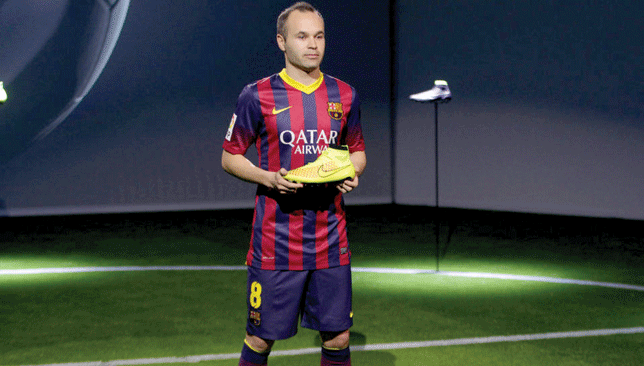
Four years ago Andres Iniesta scored one of the most important goals in football history as his solitary strike at Soccer City in Johannesburg won the World Cup for Spain.
He scored it wearing Nike boots. That last fact may not mean much to the casual observer, but at the World Cup the competition by no means starts and finishes on the pitch.
According to FIFA, 300 million people play the beautiful game and a billion watch it. The World Cup is the sport’s zenith and also the football industry’s plumpest cash cow.
Nike is the largest sportswear company on the planet with a projected $27.5 billion (Dh101bn) in revenue for 2014 and a 17 per cent market share.
Despite that, they still trail chief rivals adidas when it comes to realm of football – but the gap is closing.
The American giants only really began taking ‘soccer’ seriously in the 1990s, yet brought in $1.93bn (Dh6.9bn) in football revenue in 2013, a steady four per cent increase from $1.86bn (Dh6.6bn) in 2012.
A sizeable chunk of that is made up by the sale of boots, and this summer Nike believe they have a product which will permanently alter landscape in that particular market.
The new Magista goes on sale in the UAE this Friday, May 23, and will be worn at the World Cup by several leading stars, including Barcelona and Spain icon Iniesta.
It has taken four years to develop – with the Brazil tournament in mind – and the man who pioneered it, Nike design guru Denis Dekovic, believes it will single-handedly entrench the US firm as the market leader when it comes to boots.
He said: “I think the Magista will have the same effect on the football industry as the 1998 Nike Mercurial (famously worn by Brazil’s Ronaldo). If you look at all the boots post-Mercurial you could trace them back to that boot.
“I think Magista is the beginning of the next chapter for football boots and in the future you will see how the whole industry will evolve from here.
“The global football boot market is strong and Nike is extremely committed to it.
“We have a team of 80 people working just on that at our world HQ, we have an innovation team in Italy, development teams across Asia; and you can see with our investment in clubs and players that we are 100 per cent committed to this.
“And when Nike is committed to something, then it is to be the leaders.”
In breaking down how the Magista changes the game, it is hard to know where to start. Disregard any conventional wisdom you have about football boots. They have laces and studs, that’s where the similarity ends.
Essentially it is one large sock, which stems from players, including Iniesta, saying they feel most in control and their touch most subtle when barefoot.
This is where Nike brought in Flyknit, a pliable woven mesh previously used for running shoes. The other iconoclastic design feature is that the sock searches upwards and envelops the ankle.

The notion may sound encumbering, but as Iniesta succinctly points out: “Magista boots are like wearing gloves on your feet.”
Dekovic believes the mould has been broken and that both the shape of the boot and its fabric constitution will become the norm for all boots.
“The process (of producing the Magista) started in 2010, and pretty early on we knew we had to break some rules to elevate performance,” he explained. “That’s when we started playing with Flyknit, to see if there was any potential for football.
“We soon realised with knit we could elevate the bar a lot higher than we could with traditional materials.
“The initial idea was ambitious – we started with an ambitious dream and ended up with an amazing reality. That’s what the four years were for, making sure the Flyknit works perfectly for them. The players have had a big influence. Some of them are very good articulating what they want and what they need from a boot. Some are creative and offer ideas.
“We have spent a lot of time with the players – in the hotels before games, watching them train – it is about spending quality time with them and listening to what they have to say.
“You get all that feedback and it makes such a difference.
“With Magista they were very specific about ball feel. What they said was that they control the ball best when they are barefoot.
“Obviously they cannot play barefooted but we have tried to get as close to that feeling as possible and that is what inspired Magista.”
One thing is certain. The Magista, in an outlandish colourway Nike call volt/hyper punch, will not be missed. And Nike firmly believe it will deliver a knockout blow in the marketplace.
Factfile:
– Denis Dekovic, aged 39, was born and raised in Croatia, and has 18 years of experience in footwear design.
– As part of his expansive design career, he has lived and worked in Italy, Holland and now the United States.
– Dekovic joined Nike in 2005 and, prior to his work in global football, he worked in the women’s training division.
– Since joining Nike, Dekovic has helped design the Zoom Essential Trainer and the air Max Trainer, as well as creating the revolutionary multidirectional Diamond Flex.
– Specifically in football, Dekovic designed the Mercurial 9, the Tiempo 5 and the Hypervenom along with his team.
The Nike Magista goes on sale at Nike shops throughout the UAE on Friday, May 23, priced Dh1,499.